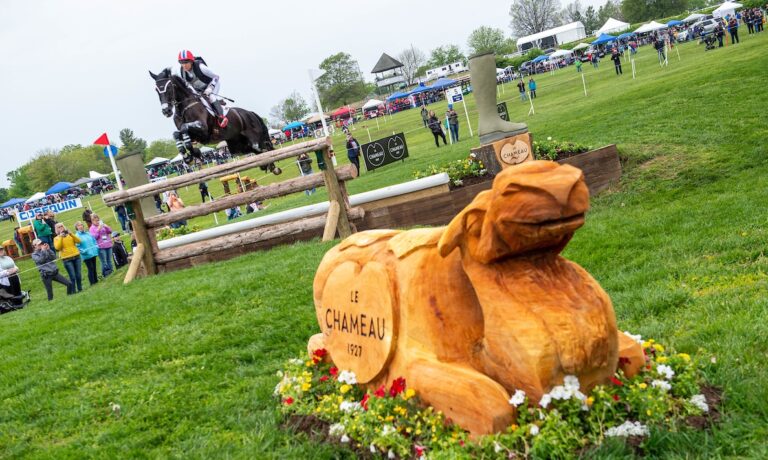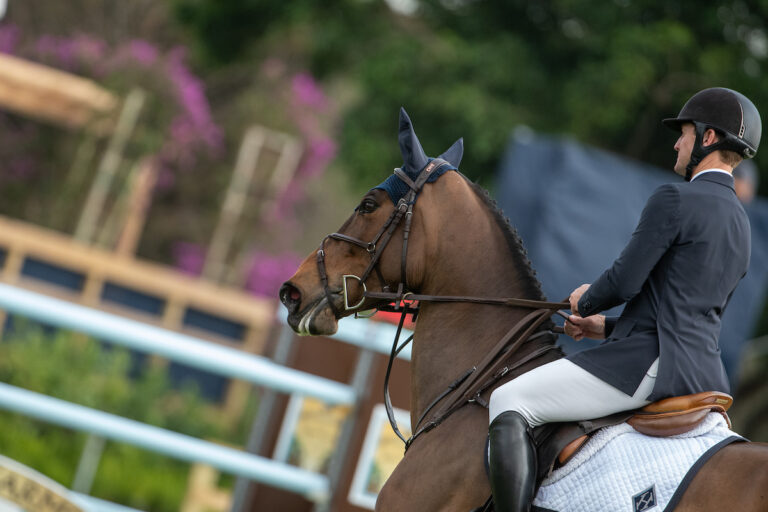On the final day of the five-day George H. Morris Horsemastership Training Session, George Morris had the young riders jump a 15-jump course created by Olympic course designer Steve Stephens. Before the jumping began, he spoke a little about his flatwork and jumping philosophy.
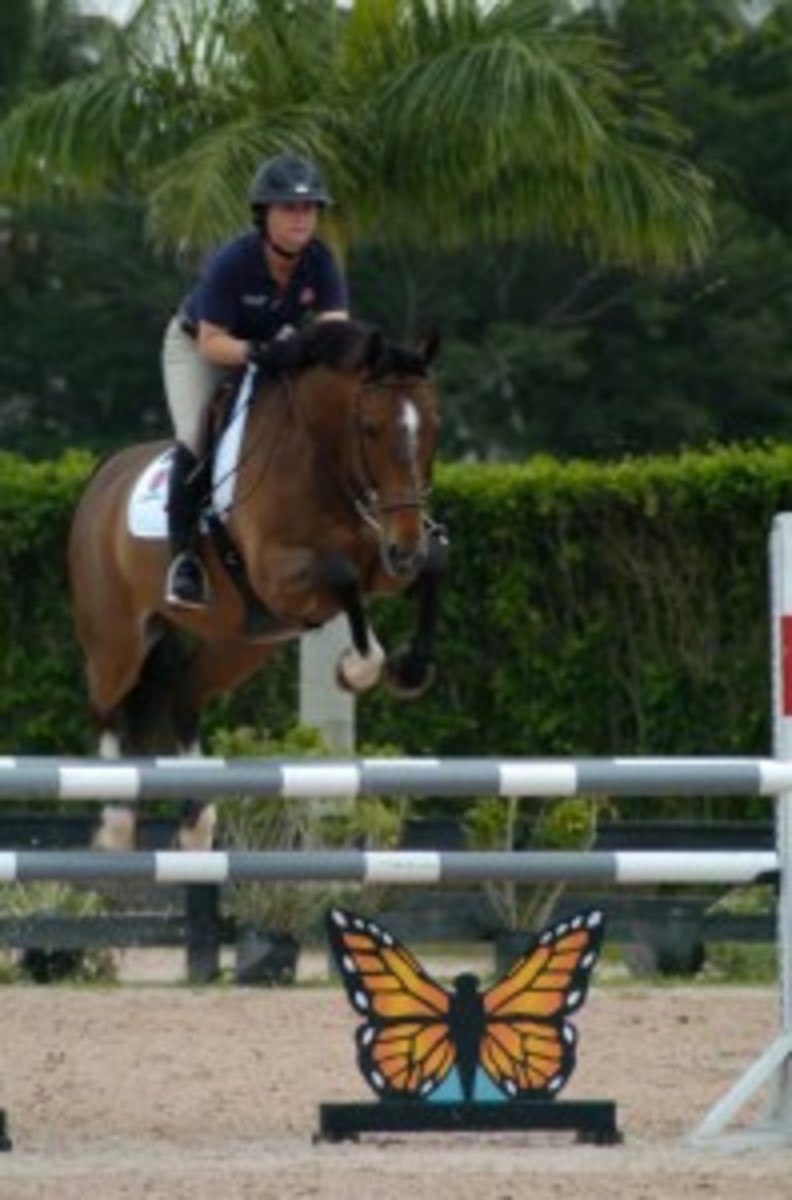
He explained that his system has evolved over the years and He’s added to it but its core hasn?t changed. For flatwork, his system is rigid. He favors a plain snaffle that is on the thin side because he thinks horses can lean on a fatter snaffle. He likes a full-cheek snaffle because it helps the horses turn, and he likes figure-eight nosebands. He is opposed to auxiliary reins, such as draw reins, because he doesn’t think they let the work from the leg come through to the hand.
He said that when he was competing, dressage was considered a ?dirty word? and would ruin the horses. But he added that riders get the horse in front of the leg and in self-carriage through dressage.
In jumping and to compete in the ring, George said, the rider needs to be educated to different bits. He then explained that Italy?s Federico Caprilli revolutionized fast riding (galloping and jumping) in the 1900s. Prior to that, people rode with long stirrups and sat back when jumping and racing, which hindered the horse’s hind end. Caprilli advocated shortening the stirrups to get the rider off the horse’s back to make it easier for the horse to do his job.
The goal of jumping coaches, George said, is to coordinate classical dressage training to school the horse on the flat, but couple it with Caprilli?s shorter stirrups and forward-seat riding when jumping.
Flatwork
Because the week had included intensive flatwork sessions and the horses would be jumping course, George had the riders warm up their horses on their own ?at will.? He said they should start simple and work up to complex.
By simple, he meant the riders should start at the walk and make sure the horses were moving with impulsion in front of their legs. First and last, he said, ?the horse is in front of your legs.? He said he usually walks for five to seven minutes, unless a horse is fresh or it’s cold. In those instances, he’ll move into a posting trot or canter/gallop in a half-seat so he doesn’t get bucked off. Other simple work is transitions, circles and serpentines.
When George moves to the trot, he always starts by posting because the sitting trot is too hard on a horse’s back when the horse is just starting out. ?I’m very aware of the fragility of a horse’s back,? he said. ?Heavy-seated riding offends me because it gives the horse a sore back.?
He works to establish rhythm at an ordinary trot, which is slower than a working trot, because a horse is not ready at this point for a quicker tempo. He doesn’t do working trot until later in the session when the horse is moving forward and connected from his hind leg to the bit.
After several minutes of simple work at the walk and trot, George told the riders to move on to more complex work: shoulder-in, haunches-in, half-pass. This type of lateral work quickly collects the horse from back to front, which ?is called engagement. It gets the horse accepting the leg,? he said.
Throughout the work, he reminded the riders of the basics. He told Victoria Colvin to make sure her stirrup iron stayed at a right angle to the girth. He had Liza Finsness shorten her reins. ?Your horse must accept a short rein,? he said. He told Lillie Keenan to hold whip over her thigh, not her hip because the whip over the hip promotes stiffness of the arm. To many riders, he said that if the horse resists the contact, close the hand in exact proportion to that resistance. He also encouraged them to frequently change direction so the horse never gets one-sided.
For canter work on the flat, George wanted the riders? seat bones fixed to the saddle. The work included walk?canter/canter?walk transitions, in which the riders should feel tall in their positions. He added that he always works on counter-canter before starting flying changes.
He also talked about hand position because ?it’s impossible to have good posture if your hands are too low.? He said that many riders are taught that if they feel resistance to lower their hands, ?but that is rewarding the horse for disobedience.? He wanted to the riders to keep their hands higher and maintain the straight line from their elbows to the horse’s mouth. ?You want to feel as if you’re pushing the horse’s head down. Don?t pull the horse’s head down,? he said. it’s important to take and give, he added. ?When I feel the outside rein and horse comes back, I instantly give.?
The ultimate questions and goal of flatwork: Does the horse go forward and back instantaneously? Does he go left and right with the same feel?

The Pulley Rein
Before the riders started jumping, George explained the use of the pulley rein, saying it is a great tool to have on a galloping horse. The lever action of the pulley rein is very strong and saves a rider from hauling on a horse’s mouth.
To use a pulley rein when traveling on a straight line, the rider sets the knuckles of the inside hand into the horse’s withers, which acts to stop the horse. With the outside hand, the rider uses a direct rein. If the horse is really strong, the rider slips the outside hand over to the inside. This rein can be used to slow down a hunter or jumper.
To use a pulley rein to turn a horse, the rider plants the knuckles of the outside hand into the withers and uses an inside opening rein to turn the horse. So if a rider is going to the right and turning left, she would set the left hand and turn with the right. The advantage of using this method to turn is that a rider doesn’t have to sit down and turn the horse with weight.
George had the riders practice the pulley rein on a straight line first at the trot and then at the gallop. To practice the pulley rein while turning, he had them canter over a crossrail and make a figure eight to change direction using the pulley rein.
With the second group of riders, he also discussed the progression of driving aids: leg, cluck, spur and stick. For example, the cluck is stronger than the leg but softer than the spur, he said.
The Jumping Warm-Up
After the flatwork, the riders raised their stirrups and warmed up the horses over what would become Fence 8, a vertical with the liverpool set on the landing side. The rails of the vertical were lowered to make a crossrail.
First George wanted riders to think about impulsion?the basis of riding. ?it’s like riding in a car or that golf-cart,? he said. ?You can’t do much with it until it’s started. I can’t do much on a horse until He’s going forward.? He said the riders would need impulsion because the crossrail was over a liverpool.

George wanted the first group of riders to work on a slightly defensive position approaching the crossrail. Eight to 10 strides in front of the fence, he told them to open their hip angles and bring their upper bodies back to the vertical. This hinders the horse’s back but is sometimes necessary to be strong, he said. As the riders trusted that their horses would jump the fence, he said they could work in three-point position, where the hip angle stayed closed and their upper bodies stayed forward. This, he said, allowed for a smoother and softer ride.
For the second session of riders, George had them start out riding in a more forward seat. When Sunny Drescher?s horse hesitated at the fence, he told her to jump it again and educate him by using the stick lightly behind the saddle to go forward.
Some of the other green horses also looked at the jump, which prompted George to tell riders that when the horse wasn?t confident and refused, they needed to go slow the next time to the fence, not faster. But later he also explained that if a horse refused, you needed to use a little spur. ?If you do nothing, you’re telling your horse that’s OK.?
Pieces of the Course
Once all of the horses had warmed up over the crossrail, George had the riders jump the lines of the course individually first, so they could work on the basics. It also helped make the horses more confident and comfortable.
They started riding Fences 1, 2 and 3. Fences 1?2 rode in seven bending strides. Fences 2?3 rode in four strides. To jump this line, George told the riders they needed to be smart with their line to the jumps. He wanted them to be perpendicular to the first jump and then drift out to get straight to the second fence for the four strides.
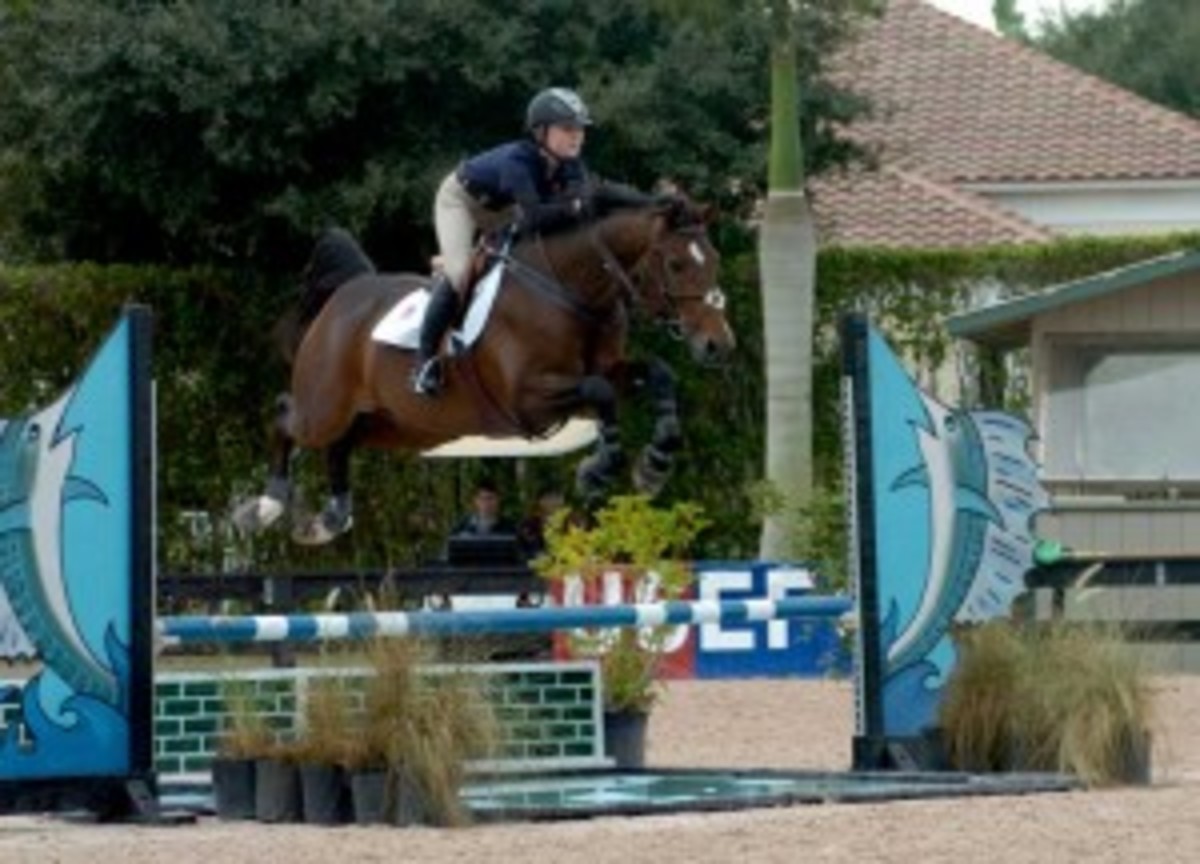
George told riders that as they worked on the pieces of the course, they should incorporate lots of halts, backing and circling after the lines, depending on the horse. Really strong horses, for example, needed to be halted and backed.
Once all of the riders had jumped the first line, he had them practice over Fences 4ABC, a triple. Over it, he had the first session of riders work on the automatic release.
?In my day, you couldn?t have won the Medal or Maclay with the crest release,? he said. Today a rider will gain bonus points using an automatic release in which she lowers the hand a few inches so there is a straight line from the elbow to the horse’s mouth. With this release, the horse takes the hand and the rider follows the gesture of his head and neck.
When approaching the triple, George told riders to focus on Fence A. ?The horse will take care of B and C automatically,? he said. Once the horse was confident through it, he warned them to not push to the B and C elements.
When some horses had trouble with this part of the course and later parts, he reminded the riders not to be tentative because a horse can sense that. ?When a horse gets tentative, you don’t get tentative,? he said. ?That’s the kiss of death. ? You get positive.?
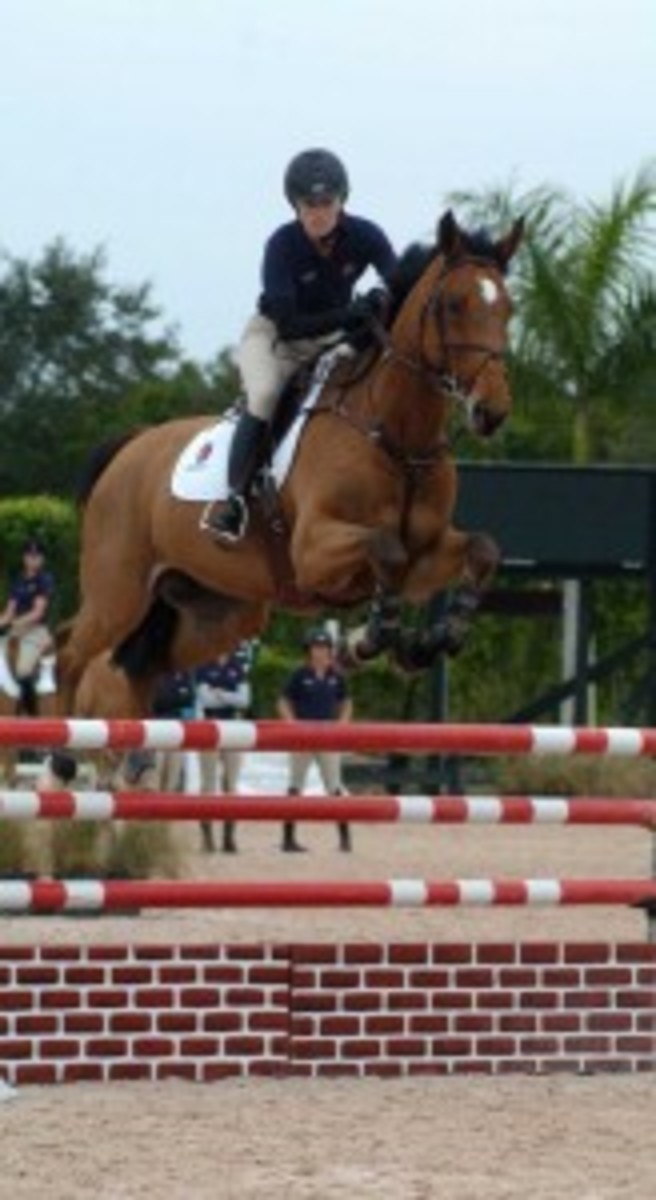
In the second session, after the triple combination, he had the riders ride the bending line to Fence 5, a large oxer, then halt a few strides in front of it to keep the horse from anticipating and rushing to it.
George next explained the importance of a turn. He was speaking of the turn from Fence 5 to Fence 6, but the principle applies to any turn and approach. He said that at the apex of the turn, if the horse was not listening to the half-halt or was cross-cantering, the rider can’t fix problems like that on course or in the show ring??that’s homework,? he said. At this point, the rider should be relaxing and letting go of the horse and focusing on the line and distance to the next fence. If you do this, You’ll ?measure the fence infinitely better,? he said.
Fence 6, an oxer, and Fence 7, a narrow vertical, were set on a straight line and rode in a balanced three strides. Fence 7 to Fence 8, a vertical with the liverpool set on the landing side, were set on a bending line and could be ridden in seven or eight strides, though George wasn?t too concerned about the number of strides in this line.
Fence 9 was an oxer centered over a liverpool. It was 69 feet to Fence 10AB, an oxer-to-vertical combination. The line rode in a short five strides to a tight one stride (26 feet). George wanted the riders to angle Fence 9 to the outside of the arena a little to make the five strides ride a little easier.
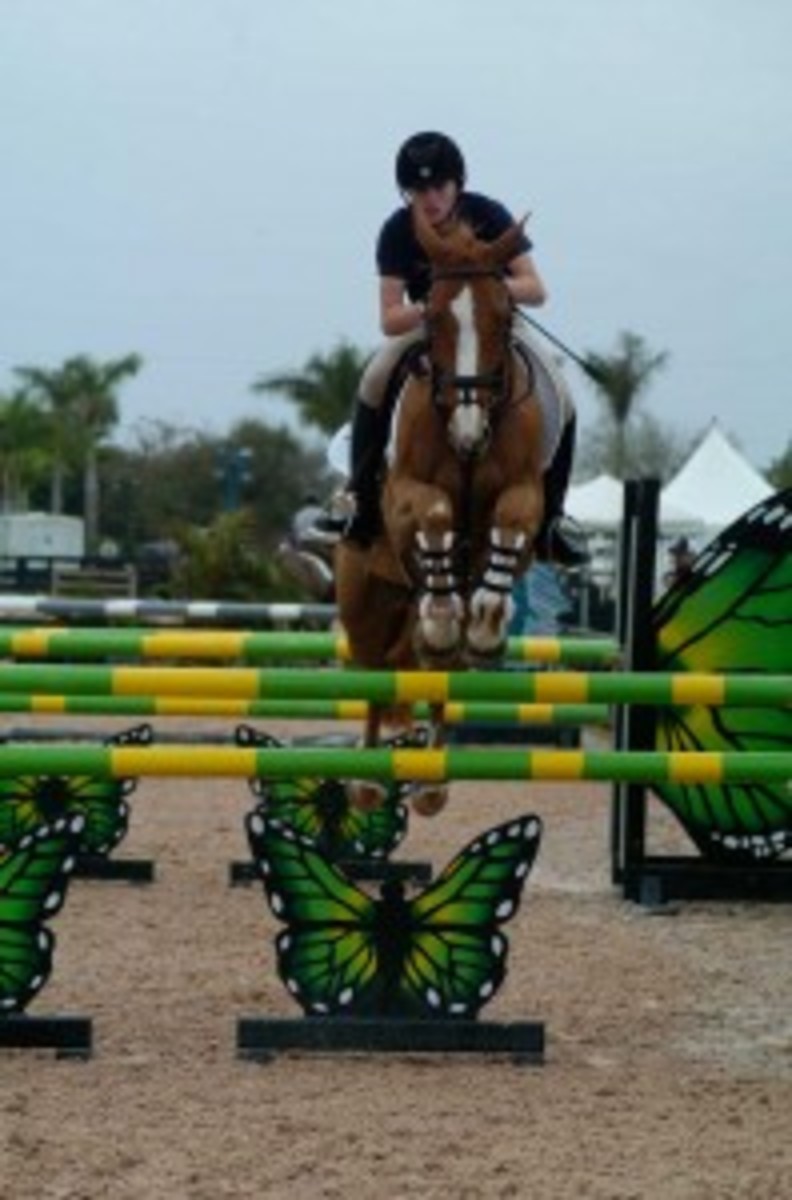
Fence 11 was a water jump that rode to Fence 12, a vertical, on a straight line. The line could be jumped on a long five strides, though riders had to be careful not letting their horses get flat, or a short six strides, which required the horse to be very obedient in coming back.
After Fence 12, George told the riders to finish with a big circle and make sure the horses were traveling from the inside leg to outside hand. He said that’s how riders should finish all their courses, whether in a hunter or jumper round.
After the riders had jumped the course, George had them ride a long approach to Fence 12, a vertical. He wanted them to gallop to the base of the fence, which helps the horse’s bascule?the ?holy grail of jumping,? he said. The goal was to ride with ?pace to the base? and then relax the reins to teach the horse to leave from the deeper distance by rocking back onto his haunches and jumping up. A horse then learns to jump round and careful.
George explained to the riders and auditors that the goal of the Horsemastership Training Session is to encourage riders to develop a professional?s mentality through the whole spectrum of horse care. What’s important, he said, is for riders to develop a system, from bedding a stall to grooming to riding, which is based on correct classics.
The George H. Morris Horsemastership Training Session is presented by the U.S. Hunter Jumper Association and supported by the U.S. Equestrian Federation, the U.S. Equestrian Team Foundation, Practical Horseman and the Winter Equestrian Festival.
To watch the riding sessions on demand, go to www.usefnetwork.com.





